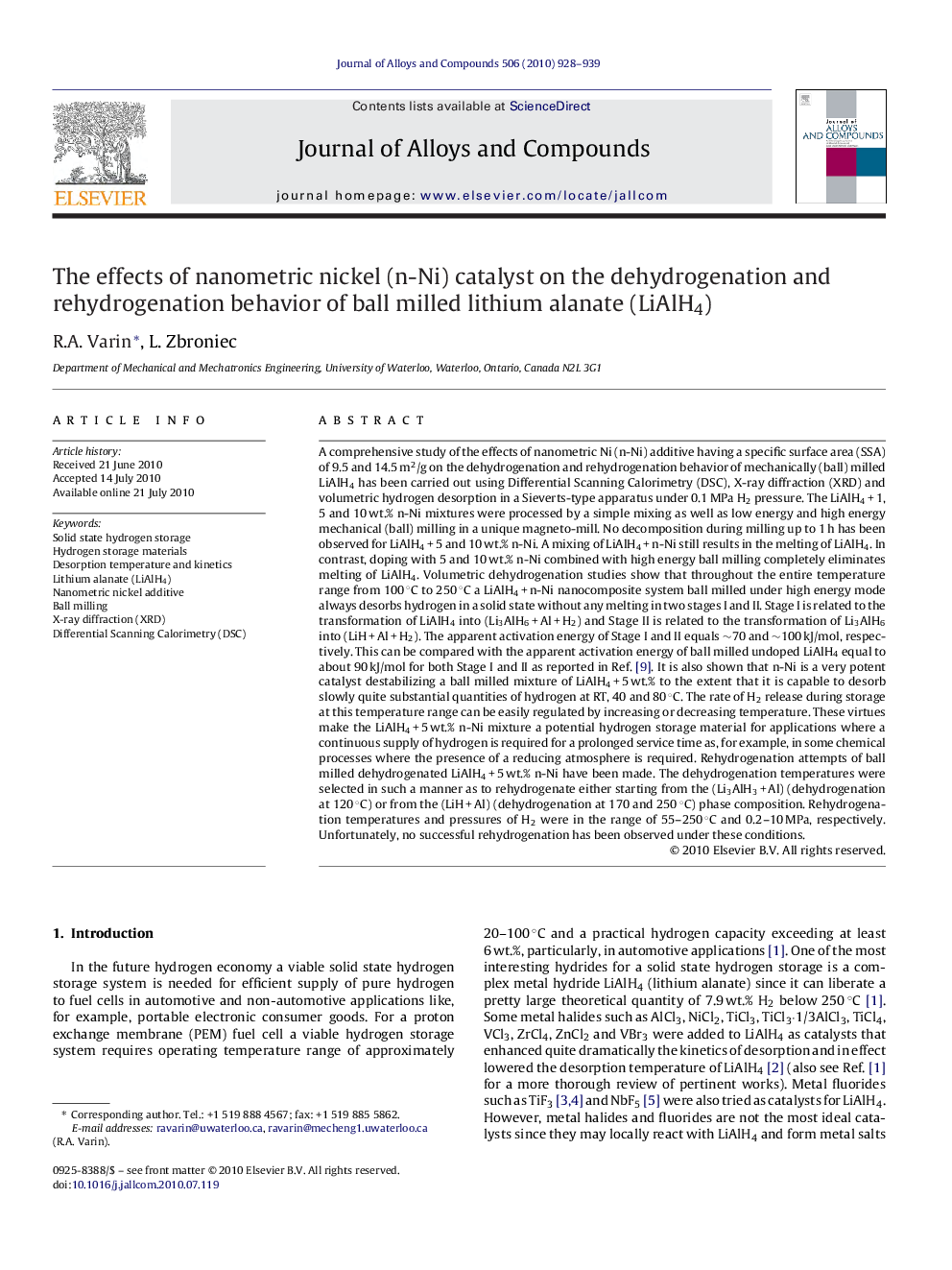| کد مقاله | کد نشریه | سال انتشار | مقاله انگلیسی | نسخه تمام متن |
|---|---|---|---|---|
| 1617933 | 1005696 | 2010 | 12 صفحه PDF | دانلود رایگان |

A comprehensive study of the effects of nanometric Ni (n-Ni) additive having a specific surface area (SSA) of 9.5 and 14.5 m2/g on the dehydrogenation and rehydrogenation behavior of mechanically (ball) milled LiAlH4 has been carried out using Differential Scanning Calorimetry (DSC), X-ray diffraction (XRD) and volumetric hydrogen desorption in a Sieverts-type apparatus under 0.1 MPa H2 pressure. The LiAlH4 + 1, 5 and 10 wt.% n-Ni mixtures were processed by a simple mixing as well as low energy and high energy mechanical (ball) milling in a unique magneto-mill. No decomposition during milling up to 1 h has been observed for LiAlH4 + 5 and 10 wt.% n-Ni. A mixing of LiAlH4 + n-Ni still results in the melting of LiAlH4. In contrast, doping with 5 and 10 wt.% n-Ni combined with high energy ball milling completely eliminates melting of LiAlH4. Volumetric dehydrogenation studies show that throughout the entire temperature range from 100 °C to 250 °C a LiAlH4 + n-Ni nanocomposite system ball milled under high energy mode always desorbs hydrogen in a solid state without any melting in two stages I and II. Stage I is related to the transformation of LiAlH4 into (Li3AlH6 + Al + H2) and Stage II is related to the transformation of Li3AlH6 into (LiH + Al + H2). The apparent activation energy of Stage I and II equals ∼70 and ∼100 kJ/mol, respectively. This can be compared with the apparent activation energy of ball milled undoped LiAlH4 equal to about 90 kJ/mol for both Stage I and II as reported in Ref. [9]. It is also shown that n-Ni is a very potent catalyst destabilizing a ball milled mixture of LiAlH4 + 5 wt.% to the extent that it is capable to desorb slowly quite substantial quantities of hydrogen at RT, 40 and 80 °C. The rate of H2 release during storage at this temperature range can be easily regulated by increasing or decreasing temperature. These virtues make the LiAlH4 + 5 wt.% n-Ni mixture a potential hydrogen storage material for applications where a continuous supply of hydrogen is required for a prolonged service time as, for example, in some chemical processes where the presence of a reducing atmosphere is required. Rehydrogenation attempts of ball milled dehydrogenated LiAlH4 + 5 wt.% n-Ni have been made. The dehydrogenation temperatures were selected in such a manner as to rehydrogenate either starting from the (Li3AlH3 + Al) (dehydrogenation at 120 °C) or from the (LiH + Al) (dehydrogenation at 170 and 250 °C) phase composition. Rehydrogenation temperatures and pressures of H2 were in the range of 55–250 °C and 0.2–10 MPa, respectively. Unfortunately, no successful rehydrogenation has been observed under these conditions.
Research highlights▶ Just a mixing of LiAlH4 with n-Ni still results in the melting of LiAlH4. ▶ Doping with 5 and 10 wt.% n-Ni combined with high energy ball milling completely eliminates melting of LiAlH4. ▶ A LiAlH4 + n-Ni nanocomposite system ball milled under high energy mode always desorbs hydrogen in a solid state in two stages. ▶ The apparent activation energy of transformation of LiAlH4 catalyzed with n-Ni into Li3AlH6 and Al is much lower than that reported so far for metal chloride catalysts. ▶ Ball milled mixture of LiAlH4 + 5 wt.% n-Ni is capable to desorb large quantities (up to ∼5 wt.%) of hydrogen at RT, 40 and 80 °C owing to the strong catalytic action of n-Ni.
Journal: Journal of Alloys and Compounds - Volume 506, Issue 2, 17 September 2010, Pages 928–939